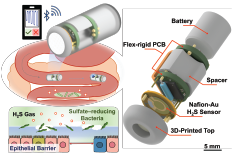Gut Health Monitoring Gas Sensors Added to Ingestible Capsule Technology
Monitoring gut health and understanding the underlying causes of gastrointestinal (GI) conditions, including irritable bowel syndrome and colorectal cancer, is an ongoing challenge in healthcare. Currently, physicians rely on invasive techniques like endoscopies to diagnose these conditions. As a groundbreaking alternative, researchers working in Professor Reza Ghodssi’s (ECE/ISR/Fischell Institute Fellow) MEMS Sensors and Actuators Laboratory (MSAL) at the University of Maryland (UMD) have been advancing a non-invasive, ingestible capsule that uses wireless technology to provide information to diagnosticians in real time. (The capsule is in development and not currently available to the medical community.) The latest version of the capsule includes sensors for electrochemical gas detection—critical to improved disease diagnosis and management. The concentration, type and volume of intestinal gases are indicators of gut health, and their presence can indicate chronic GI conditions like inflammatory bowel disease. MSAL has published this new research development in the journal Advanced Healthcare Materials. “Miniaturized Capsule System Towards Real-time Electrochemical Detection of H2S in the Gastrointestinal Tract” was written by alumnus and current MATRIX Lab Assistant Research Scientist Justin Stine (ECE Ph.D. 2023), alumnus Hossein Abianeh (EE BS 2022), ECE Ph.D. student Katie Ruland and MSE Ph.D. student Joshua Levy, UMD Research Associate Luke Beardslee, UMD Visiting Assistant Professor Santiago Botasini, Mayo Clinic gastroenterologist Pankaj J. Pasricha, and Ghodssi. Ghodssi is the Ph.D. advisor for both Ruland and Levy. “The paradigm of ingestible capsules has long fulfilled a diagnostic role for minimally invasive screening, taking images, and measuring our body’s physiology,” Dr. Ghodssi said. “Emerging capsules are challenged to sense complex biomarkers that demand advanced functionality. This makes systems integration and data learning techniques essential to capsule design.” New gas sensor capabilities Very few ingestible capsule devices have electrochemical sensing capabilities, and the new version of the MSAL capsule is the only one capable of selectively detecting hydrogen sulfide (H2S) in the GI tract. H2S is a colorless gas known for its rotten egg smell. Low levels of H2S help maintain GI homeostasis by rebuilding mucus layers and healing injury and inflammation. High levels can be indicative of intestinal disorders. Being able to monitor patterns in rising and falling levels of H2S will provide insight into how this gas’s production influences gut health and disease progression, helping researchers explore causes of inflammation and improving wellness assessments. “Hydrogen sulfide, like several other gases, is now known to have several physiological effects that are important for health and disease. The gut is an important site for production of H2S, particularly by the microbiome,” Dr. Pasricha said. “The ability to monitor the levels of this gas by an ingestible capsule has the potential for being a useful biomarker, both for diagnosis and for monitoring the response to therapy in conditions such colitis and irritable bowel syndrome.” The capsule now includes a gold (Au) sensor specially sealed to protect its sensitive electronics from surrounding moisture. It is modified with a Nafion solution (Nafion-Au). Nafion is a stable, biocompatible, fluoropolymer-copolymer often used in biosensors; here it increases sensitivity and selectivity towards H2S in humid environments like the gut. Nafion also maintains excellent chemical and mechanical stability under harsh conditions. A Teflon filter is placed over the sensor to minimize fouling and protect the Au-Nafion sensor from the acidity of the gut. Existing electrochemical H2S gas sensors are inoperable under humid conditions and are sensitive to interfering gases such as hydrogen (H2). By leveraging the molecular selectivity and conductive properties of Nafion, the gold electrochemical sensor in the MSAL capsule is more effective. Dr. Giovanni Traverso, an associate professor in Mechanical Engineering at MIT and a gastroenterologist at Harvard Medical School’s Brigham and Women’s Hospital, is an expert in biomedical device development, ingestible robotics, and drug delivery. He provided his perspective on the capsule: “This unique design helps tackle challenges of hydrogen sulfide detection in the GI tract and progresses the field of gas-sensing capsules. I am eager to see how the next generation of ingestible capsule platforms will translate and evolve with emerging healthcare needs.” “A focal point of our work was to demonstrate the feasibility of electrochemical measurement and embrace design choices that allow for modular integration of subsequent capabilities for smart capsules,” said Dr. Stine. “There is tremendous potential for leveraging low-power sensing to enable autonomous operation of ingestible microsystems, and I look forward to contributing to this important endeavor.” Advances in flexible electronics, chemical sensors, and smart packaging are making ingestible gas-sensing technologies like this capsule possible. The capsule design marries state-of-the-art technologies including portable electrochemical readout circuitry, device encapsulation using 3D printing, and wireless communication. The work has tremendous implications for monitoring disease progression and assessing gut health. Once it is in use, the capsule will help usher in a new era of less-intrusive diagnostics. It will be able to integrate other capsule modules that the lab is researching to sense biomarkers in the small intestines that invasive procedures currently cannot sense. Eventually, the hope is that fewer diagnostic colonoscopies and endoscopies will be needed. ### MSAL’s history of ingestible capsule innovations MSAL has been developing versions of the capsule for six years. Here are some of the innovations during this time.
Some of the most recent presentations include:
This work was supported by the National Science Foundation ECCS Program. The authors also received support from TerrapinWorks and the Nanocenter FabLab at the University of Maryland as well as the Clark Mid-Career Doctoral Fellows Program.
Related Articles: December 14, 2023 Prev Next |


